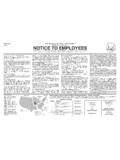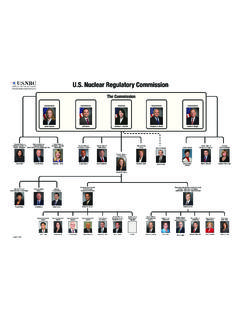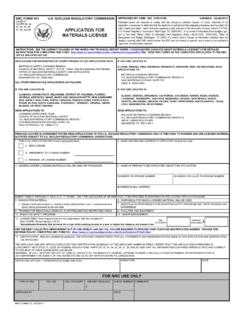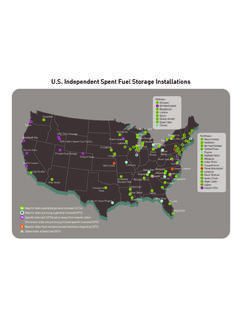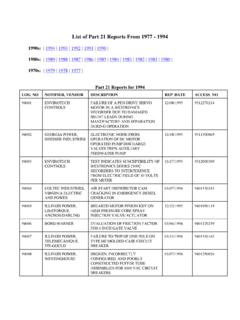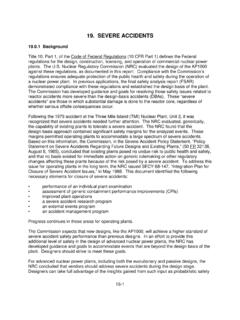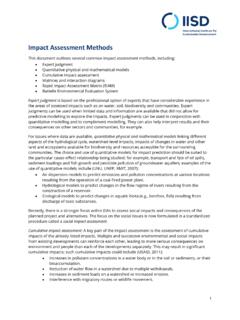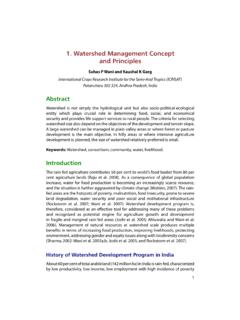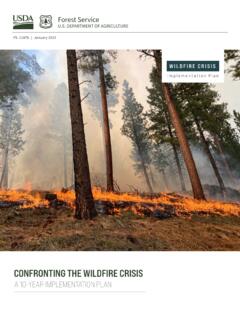Transcription of Principles for a Strong Nuclear Safety Culture.
1 Building on the < Strong >PrinciplesStrong > for Enhancing Professionalism < Strong >PrinciplesStrong > for a Strong < Strong >NuclearStrong > < Strong >SafetyStrong > Culture November 2004 Copyright 2004 by the Institute of < Strong >NuclearStrong > Power Operations. Not for sale nor for commercial use. All other rights reserved. NOTICE: This information was prepared in connection with work sponsored by the Institute of < Strong >NuclearStrong > Power Operations (INPO). Neither INPO, INPO members, INPO participants, nor any person acting on the behalf of them (a) makes any warranty or representation, expressed or implied, with respect to the accuracy, completeness, or usefulness of the information contained in this document, or that the use of any information, apparatus, method, or process disclosed in this document may not infringe on privately owned rights, or (b) assumes any liabilities with respect to the use of, or for damages resulting from the use of any information, apparatus, method, or process disclosed in this document.
2 < Strong >PrinciplesStrong > for a Strong < Strong >NuclearStrong > < Strong >SafetyStrong > Culture i Introduction < Strong >PrinciplesStrong > for a Strong < Strong >NuclearStrong > < Strong >SafetyStrong > Culture describes the essential attributes of a healthy < Strong >NuclearStrong > < Strong >SafetyStrong > culture (hereafter < Strong >SafetyStrong > culture ), with the goal of creating a framework for open discussion and continuing evolution of < Strong >SafetyStrong > culture throughout the commercial < Strong >NuclearStrong > electric generating industry. The < Strong >PrinciplesStrong > and associated attributes described have a Strong basis in plant events. Basic < Strong >PrinciplesStrong > are addressed herein, rather than prescribing a specific program or implementing methods. These < Strong >PrinciplesStrong > and attributes, when embraced, will influence values, assumptions, experiences, behaviors, beliefs, and norms that describe what it is like to work at a specific facility and how things are done there.
3 < Strong >PrinciplesStrong > appear in boldface type. Attributes help clarify the intent of the < Strong >PrinciplesStrong > . Utility managers are encouraged to make in-depth comparisons between these < Strong >PrinciplesStrong > and their day-to-day policies and practices and to use any differences as a basis for improvement. This document is complementary to, and should be used in conjunction with, previously published < Strong >PrinciplesStrong > documents. It builds on and supports < Strong >PrinciplesStrong > for Enhancing Professionalism of < Strong >NuclearStrong > Personnel, March 1989. It contains concepts consistent with those described in Management and Leadership Development, November 1994; Excellence in Human Performance, September 1997; < Strong >PrinciplesStrong > for Effective Self-Assessment and Corrective Action Programs, December 1999; and < Strong >PrinciplesStrong > for Effective Operational Decision-Making, December 2001.
4 This document was developed by an industry advisory group in conjunction with the staff of the Institute of < Strong >NuclearStrong > Power Operations (INPO) and with broad input from the < Strong >NuclearStrong > industry worldwide. < Strong >PrinciplesStrong > for a Strong < Strong >NuclearStrong > < Strong >SafetyStrong > Culture ii Background A variety of watershed events over the years have influenced the < Strong >SafetyStrong > culture at < Strong >NuclearStrong > electric generating plants. The industry had its first significant wake-up call in 1979 as a result of the accident at Three Mile Island < Strong >NuclearStrong > Station. Many fundamental problems involving hardware, procedures, training, and attitudes toward < Strong >SafetyStrong > and regulation contributed to the event. In 1986, the Chernobyl accident was a stark reminder of the hazards of < Strong >NuclearStrong > technology.
5 This accident resulted from many of the same weaknesses that led to the Three Mile Island accident. In addition, it highlighted the importance of maintaining design configuration, plant status control, line authority for reactor < Strong >SafetyStrong > , and cultural attributes related to < Strong >SafetyStrong > . Response from industry and regulatory organizations to both these events was sweeping. Improvements were made in standards, hardware, emergency procedures, processes, training (including simulators), emergency preparedness, design and configuration control, testing, human performance, and attitude toward < Strong >SafetyStrong > . More recent events, such as the 2002 discovery of degradation of the Davis-Besse < Strong >NuclearStrong > Power Station reactor vessel head, have highlighted problems that develop when the < Strong >SafetyStrong > environment at a plant receives insufficient attention.
6 A theme common in these cases is that, over time, problems crept in, often related to or a direct result of the culture at the plant. Had these problems been recognized and resolved, the events could have been prevented or their severity lessened. The series of decisions and actions that resulted in these events can usually be traced to the shared assumptions, values, and beliefs of the organization. These events and the notion that culture is a key ingredient in the overall success of the plant form the basis for this document. Organizational culture is the shared basic assumptions that are developed in an organization as it learns and copes with problems. The basic assumptions that have worked well enough to be considered valid are taught to new members of the organization as the correct way to perceive, think, act, and feel.
7 Culture is the sum total of a group s learning. Culture is for the group what character and personality are for the individual. < Strong >PrinciplesStrong > for a Strong < Strong >NuclearStrong > < Strong >SafetyStrong > Culture iii In addition to a healthy organizational culture, each < Strong >NuclearStrong > station, because of the special characteristics and unique hazards of the technology radioactive byproducts, concentration of energy in the reactor core, and decay heat needs a Strong < Strong >SafetyStrong > culture. < Strong >SafetyStrong > culture: An organization s values and behaviors modeled by its leaders and internalized by its members that serve to make < Strong >NuclearStrong > < Strong >SafetyStrong > the overriding priority. Implied in this definition is the notion that < Strong >NuclearStrong > power plants are designed, built, and operated (and intended) to produce power in a safe, reliable, efficient manner; that the concept of < Strong >SafetyStrong > culture applies to every employee in the < Strong >NuclearStrong > organization, from the board of directors to the individual contributor; that the focus is on < Strong >NuclearStrong > < Strong >SafetyStrong > , although the same < Strong >PrinciplesStrong > apply to radiological < Strong >SafetyStrong > , industrial < Strong >SafetyStrong > , and environmental < Strong >SafetyStrong > ; and that < Strong >NuclearStrong > < Strong >SafetyStrong > is the first value adopted at a < Strong >NuclearStrong > station and is never abandoned.
8 The strength of a facility s < Strong >SafetyStrong > culture could lie anywhere along a broad continuum, depending on the degree to which the attributes of < Strong >SafetyStrong > culture are embraced. Even though < Strong >SafetyStrong > culture is a somewhat intangible concept, it is possible to determine, based on observable attributes, whether a station tends toward one end of the continuum or the other. A < Strong >SafetyStrong > -conscious work environment (freedom to raise concerns without fear of retribution) is but one (albeit important) element of a Strong < Strong >NuclearStrong > < Strong >SafetyStrong > culture. Commercial < Strong >NuclearStrong > electric generating plants are designed, built, and operated to produce electricity. < Strong >SafetyStrong > , production, and cost control are necessary goals for the operation of such a plant.
9 These outcomes are quite complementary, and most plants today achieve high levels of < Strong >SafetyStrong > , impressive production records, and competitive costs, reinforced by decisions and actions made with a long-term view. This perspective keeps < Strong >SafetyStrong > as the overriding priority for each plant and for each individual associated with it. < Strong >NuclearStrong > < Strong >SafetyStrong > is a collective responsibility. No one in the organization is exempt from the obligation to ensure < Strong >SafetyStrong > first. This page intentionally left blank. < Strong >PrinciplesStrong > for a Strong < Strong >NuclearStrong > < Strong >SafetyStrong > Culture 1 < Strong >PrinciplesStrong > for a Strong < Strong >NuclearStrong > < Strong >SafetyStrong > Culture < Strong >SafetyStrong > culture: An organization s values and behaviors modeled by its leaders and internalized by its members that serve to make < Strong >NuclearStrong > < Strong >SafetyStrong > the overriding priority.
10 The following < Strong >PrinciplesStrong > are described in this document: 1. Everyone is personally responsible for < Strong >NuclearStrong > < Strong >SafetyStrong > . 2. Leaders demonstrate commitment to < Strong >SafetyStrong > . 3. Trust permeates the organization. 4. Decision-making reflects < Strong >SafetyStrong > first. 5. < Strong >NuclearStrong > technology is recognized as special and unique. 6. A questioning attitude is cultivated. 7. Organizational learning is embraced. 8. < Strong >NuclearStrong > < Strong >SafetyStrong > undergoes constant examination. < Strong >PrinciplesStrong > for a Strong < Strong >NuclearStrong > < Strong >SafetyStrong > Culture 2 < Strong >PrinciplesStrong > and Their Attributes 1. Everyone is personally responsible for < Strong >NuclearStrong > < Strong >SafetyStrong > . Responsibility and authority for < Strong >NuclearStrong > < Strong >SafetyStrong > are well defined and clearly understood. Reporting relationships, positional authority, staffing, and financial resources support < Strong >NuclearStrong > < Strong >SafetyStrong > responsibilities.
